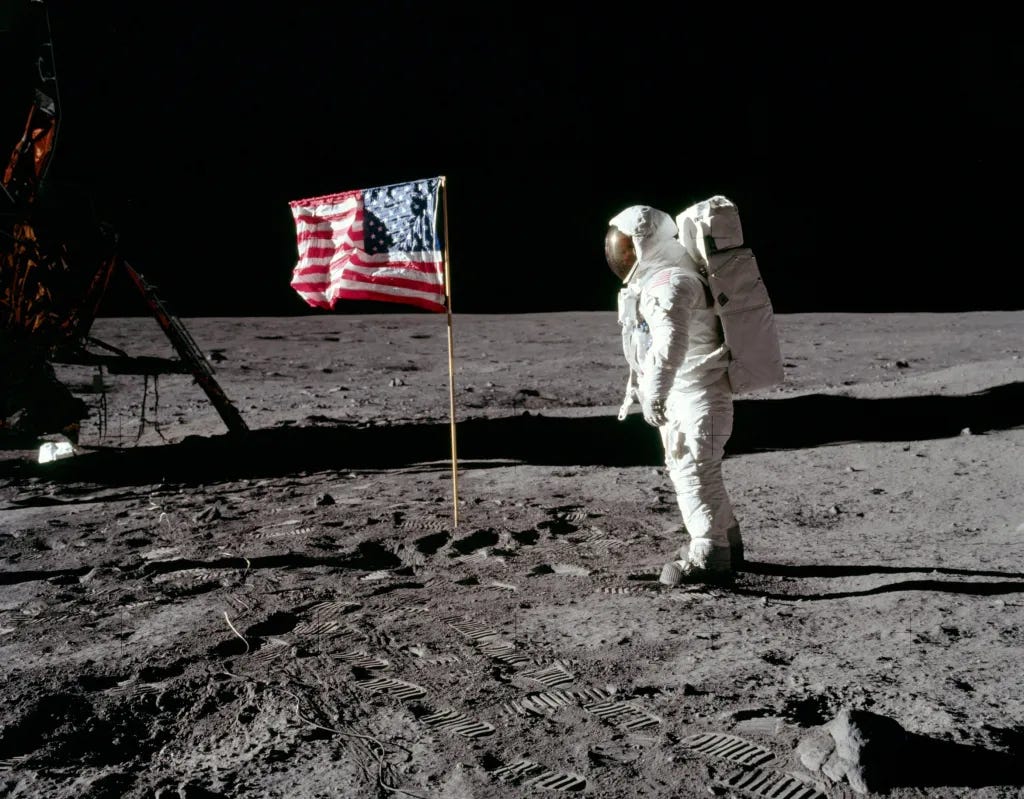Welcome to Thursday Things! If you enjoy this edition, please click the heart icon in the header or at the end of the post to let me know.
“A kibble in every bowl!” Photo by Caleb Fisher on Unsplash
Pirates of the Metric System
There are two kinds of countries in the world — those that use the metric system and those that have put a man on the moon.1
“We didn’t get here thinking in centimeters.” Image: NASA
I’m going to keep using that line for as long as I can. It astounds people around the world that the US still doesn’t use the metric system. My guess is Monaco will put a man on the moon before the US goes metric. But why exactly is the red, white, and blue so resistant to decimal based weights and measures?
This article blames pirates:
A Pirate Attack in 1794 is why the United States doesn’t use the Metric System
The name of Joseph Dombey can be found in many 18th century botanical textbooks but remains largely forgotten in our time. Even though the French botanist was a man of science, on several occasions Dombey was involved in political affairs, which ultimately led to his death in 1794 at the hands of British privateers.
He had encountered the British several times previously, as his botanical collections shipped from South America to France were intercepted, captured, and sent to the British Museum where they are exhibited to this day.
Very on brand for the British.
But what has this to do with the metric system? Let’s sail on…
During his final voyage in 1794, Dombey was on his way to the United States, where he was to present the French measurement standards representing one meter and one grave―an old measure for weight that was replaced by the kilogram. The United States had declared independence from the United Kingdom some 18 years earlier, but kept the traditional British system of weights and measures.
Mostly we were mad about the tax on tea, not how it was measured.
Thomas Jefferson, an admirer of French scientific achievements, wanted to host Dombey, who was primarily sent to strengthen the ties between France and the U.S. by signing an agricultural agreement.
Jefferson was at the time lobbying Congress to abandon the British measures in favor of the French system, which was the predecessor of the metric system that is used in most countries today. For this, he needed an experienced scientist like Dombey and the physical objects made of copper, representing the length and the weight of the new measures.
So Dombey set sail for Philadelphia from the French port of Le Havre, only to be captured en route by British privateers…
The upshot was that Dombey and his PowerPoint presentation on the benefits of going metric never made it to Washington. The French diplomat died while a prisoner of the privateers. His sample meter and grave (kilogram) were auctioned off, and America continued merrily on the with our pounds, ounces, yards, furlongs, and miles.
Eventually Andrew Ellicot, surveyor of the District of Columbia, ended up with the copper grave. It ultimately found its way into the possession of the U.S. government, more than a century and a half after Dombey’s ill-fated journey:
Ellicot’s family owned Dombey’s copper grave until 1952, when they decided to donate this particular piece of history to the National Institute of Standards and Technology, where it remains exhibited.
It’s a neat story. I do like pirates as the reason Americans measure things with YAHRRRDsticks instead of metersticks. But the sad tale of Dombey’s last voyage is probably an oversimplification of why the US never went metric.
As this Britannica article explains, it likely has more to do with the cost and hassle of switching:
Why Doesn’t the U.S. Use the Metric System?
The biggest reasons the U.S. hasn’t adopted the metric system are simply time and money. When the Industrial Revolution began in the country, expensive manufacturing plants became a main source of American jobs and consumer products. Because the Imperial System (IS) of measurements was in place at this time, the machinery used in these factories was developed to size in IS units; all of the workers were trained to deal with IS units; and many products were made to feature IS units. Whenever the discussion of switching unit systems arose in Congress, the passage of a bill favoring the metric system was thwarted by big businesses and American citizens who didn’t want to go through the time-consuming and expensive hassle of changing the country’s entire infrastructure.
As far as the USA is concerned, the metric system just doesn’t measure up!2
“Gather ‘round, lads and I’ll tell you why we mark where the treasure is buried in paces and not meters.” Photo by Nadjib BR on Unsplash
More dog mayors
Can there ever be too many dog mayors?
This article from a couple of years ago provides a guide to past and present dog mayors around the country.
Who Knew—7 Dogs Have Held the Office of Mayor in the US
The list includes the late Mighty Max and Mighty Max II, featured in Thursday Things last week. The article was published prior to the passing of Mighty Max II and the accession of his successor, Mayor Mighty Max III.
As it turns out, Idyllwild, California is not the only town to opt for a canine form of government (caninocracy?). Rabbit Hash, Kentucky has elected a series of dog mayors since 1998:
Brynneth Pawltro, Rabbit Hash, KY
Brynn, a pit bull, is the fourth dog mayor of quirky Rabbit Hash, Kentucky. She is preceded by Lucy Lou, Junior Cochran, and Goofy Borneman (featured below). Rabbit Hash charges a $1 donation per vote.
One of Mayor Brynn’s predecessors even flirted with a campaign for the presidency:
Lucy Lou, Rabbit Hash, KY
Lucy Lou, a Border collie, was mayor of Rabbit Hash from 2008 to 2016. She went on to consider a bid for the presidency, but decided to stay home to enjoy a comfy retirement instead.
Which, in that year, may have been a good call.
The mayors Max, meanwhile, were not California’s only canine chief executives:
Bosco, Sunol, CA
Bosco, a Labrador and Rottweiler mix, was the mayor of Sunol, California from 1981 until his death in 1994. Bosco had a statue dedicated to him in 2008, which graces the Post Office of Sunol.
Also profiled is Duke, the Great Pyrenees former mayor of Cormorant, Minnesota. North, south, east, and west — America loves dog mayors! Duke passed away in 2019.
The late Mayor Duke. Source: Mayor Duke of Cormorant Village/Facebook via Daily Mail
Thank you for reading!
Please click the hearts, leave a comment, and use the share feature to send this issue to a friend who might enjoy it. See you next Thursday!
There are also Myanmar and Liberia, which have neither adopted the metric system nor, to the best of my knowledge, landed anyone on the moon. But I’m ignoring them.
Not to be overlooked is the McDonald’s factor: “No metric system, no Quarter Pounder.”—Amy Drew Thompson, orlandosentinel.com, 27 Aug. 2020






